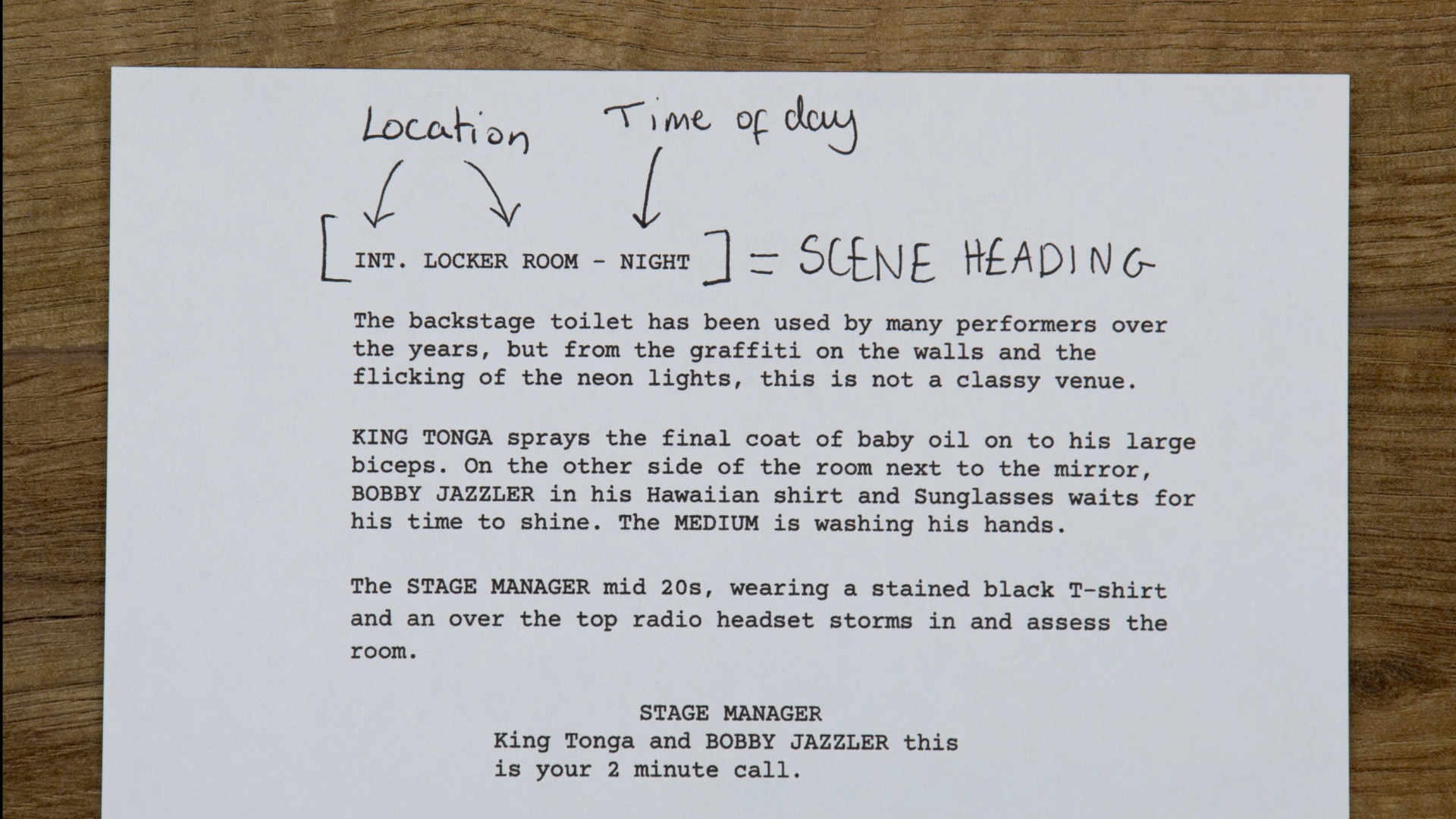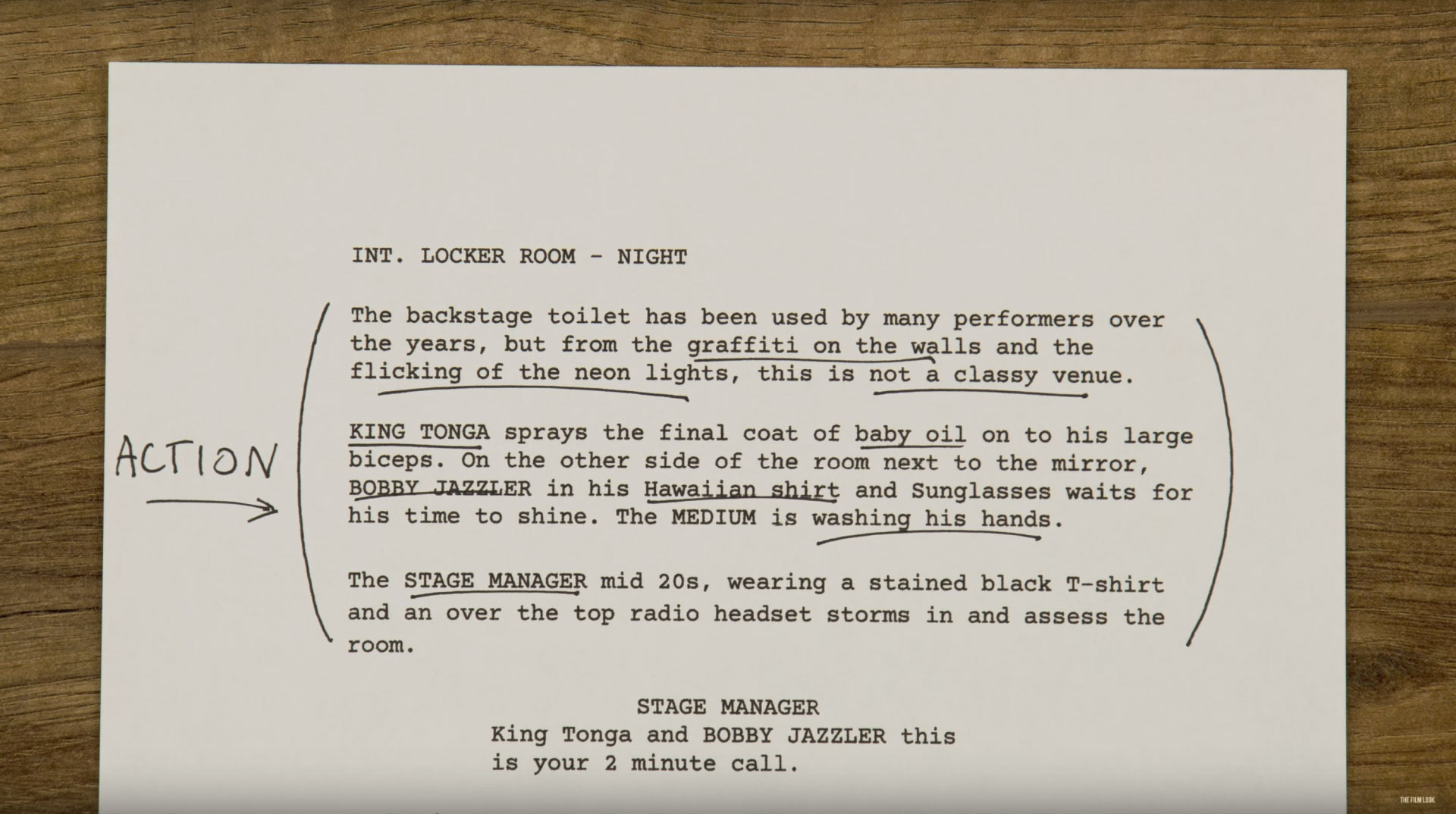YOU just came up with an awesome story that you want to turn into a film. What do you do now? It’s time to get that story written on paper - let's write a script!
A script (or screenplay) is the backbone of your film. It is the blueprint you’ll follow when you plan, shoot, and edit your movie.
In the last episode we spoke about storytelling, structure, and using “character, conflict, goal” to craft a compelling plot. Now it’s time to put that into practice and draft a formatted screenplay.
Firstly let's breakdown the elements of a screenplay using a page from our latest film BACKSTAGE.
A scene always starts with a scene heading. The scene heading is there to tell you the location and time of day of the scene you’re about to read.
It always begins with INT or EXT, signifying if the scene is inside or outside.
Then a brief description of the location, for example, LOCKER ROOM. This is followed by the time of day: DAY or NIGHT are standard descriptions, but if you plan on shooting in a certain light, you can be more specific like GOLDEN HOUR or DAWN.
Next you have action; this is where you place the narrative description of events in the scene. This is the meat of the script, so in here you can describe characters, the events, the location and character interaction.
When a character is introduced for the first time, their name should be in ALL CAPS. This is to clearly identify that this is a new character who we haven’t seen yet.
After that, you should use sentence case with a capital letter at the beginning of their name.
Next up we have dialogue. It always starts with the character’s name in ALL CAPS in the centre of the page. Underneath you have the written lines in sentence case.
We won’t be getting into the nitty gritty of margins, spacing, and indents. With screenwriting programs such as Celtx and Final Draft doing all of this for you, I won’t bore you with it.
Next up we have parentheticals. These are seen as small descriptions placed between a character’s name and their dialogue inside parentheses. They have multiple uses, and all link to the dialogue being performed.
They can be used to indicate where a line is being outputted, such as FROM PHONE.
They can be used if a line of dialogue needs to be performed a specific way, such as SARCASTICALLY.
They can also be used when a character is addressing a specific character in the scene, such as TO BOBBY JAZZLER.
You can SOMETIMES use parentheticals in replace of action, such as TAKES OFF GLOVES. This should only be used if the action can be written with very few words and is delivered during the line. Otherwise, break from the dialogue and write it out as an action line.
Parentheticals should be used sparingly, and it’s common to see parentheticals unused in a script altogether. If you don’t know whether to use them, just leave them out.
There are a few more intricate details you can add to your script, but this is a good starting point to formatting. So now you know the basics, what's next?
It’s time to start filling out the action. If you have some brief notes from your beat sheet such as “a bunch of wrestlers are getting ready for the fight” you can now turn it into something more descriptive.
Just remember to avoid writing anything which is unfilmable; by this I mean anything which you can’t capture on screen.
Instead of writing “the locker room smells like a boys bedroom” describe the pile of dirty laundry in the corner. Try to limit describing anything you can’t point a camera or microphone towards.
And don’t write anything which jumps into the role of another filmmaker. If you describe a character’s eye and hair colour, the casting director will be limited. If you start describing all of the camera angles, you’re doing the job of the cinematographer.
Once you have a finished draft, it doesn’t have to stop there! A first draft is a good starting point, but there will always be room for improvement. We have a bunch of videos on our channel on ways to improve your script writing. I’ve put a link to our Writing Playlist if you want to check them out.
And once you’ve written your first draft, print it off, and give it to someone to read. They might notice something you don’t.
Free screenwriting software I use: https://www.celtx.com/
This video was Sponsored By
🎵 http://bit.ly/track-rollthedice - Thanks to PremiumBeat.com for sponsoring the episode! Click here to download this episode's track. Check out Premiumbeat.com to discover a huge range of exclusive royalty free music!
DISCLAIMERS:
Some of these links are affiliate links, if you purchase gear via these links The Film Look will receive a small commission, but there will be no additional cost to you. Thank you!





